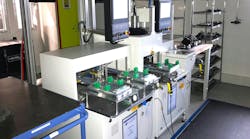EAST GRANBY, Conn. — Fiber-optic lasers are emerging as promising candidates for future weapons-grade solid-state laser systems on jet fighters, land vehicles, and perhaps even man-portable systems.
Fiber lasers even have the potential to edge-out other solid-state laser approaches such as slab lasers and free-electron lasers, say experts at Nufern, a specialty optical- fiber manufacturer in East Granby, Conn.
Fiber lasers are more efficient, more easily cooled, small and lightweight, and relatively straightforward to scale up in power, which strengthens their position for future laser weapons programs, says Michael O'Connor, product line manager of laser products at Nufern.
Up to now, weapons-grade lasers primarily have been large, complicated devices capable of operating on large platforms such as jumbo jets, surface ships, and large tractor-trailers. Solid-state lasers, however, have the potential in the near term to operate on relatively small platforms such as jet fighters where they could destroy land vehicles, missiles, or other aircraft.
As a baseline to help gauge the progress of solid-state lasers toward weapons-grade quality, the U.S. Air Force Joint High-Power Solid-State Laser (JHPSSL) program plays a central role.
JHPSEL, which involves Raytheon Co., Northrop Grumman Corp., and the Lawrence Livermore National Laboratory, seeks to demonstrate a 25-kilowatt solid-state laser by the end of 2005. Many experts say that 100-kilowatt lasers ultimately will be necessary for weapons applications.
Nufern experts have demonstrated in the laboratory a one-kilowatt fiber laser using one 400-micron strand of double-clad erbium-doped fiber, amplified optically with no free-space lasers. O'Connor says Nufern scientists plan to increase that output to 25 kilowatts by beam combining, light amplification, and by ganging fibers together.
Optical fiber has several benefits where laser systems are concerned, O'Connor says. "Fiber is 60 to 80 percent efficient; it creates half the heat per photon generated as do crystal or disk lasers."
Efficiency has a direct bearing on cooling, which is one of the most prominent challenges to generating 25 kilowatts with a solid-state laser. "Crystal is inefficient in dissipating heat and generating laser light at the desired wavelength," O'Connor says.
"Crystal is 40-percent efficient optical to optical," compared to fiber that is at least 60 percent efficient, and disk lasers that are around 45 percent efficient, he says. "That means you need to dissipate 60 percent heat." Further, O'Connor says a phenomenon called thermal lensing, which concerns a steep temperature gradient of crystal from the inside out can distort a laser beam.
O'Connor points to the tiny diameter of optical fiber as its chief advantage where cooling issues are concerned. "The fiber laser offers virtually nothing to dissipate heat out of," he says. "You can run at powers as high as 100 watts without any active cooling at all. If you cool the fiber, you cool the laser."
As far as photon throughput is concerned, Nufern engineers have a plan to squeeze as much out of their double-clad erbium-doped fiber as possible. "With double-clad fiber, you pump the cladded region in addition to the five-micron glass core," O'Connor says. The cladded area is 125 microns thick.
While Nufern's standard double-clad fibers are about 400 microns thick, company experts are capable of manufacturing fiber that is 800 microns thick, which could increase photon throughput even more. Still, plans do not stop at a single fiber.
O'Connor says Nufern experts plan to increase laser output by bundling laser fibers together. "We need about 250 fibers, and will run them through a coil box," he says.
In addition, Nufern experts are looking into new amplifier designs that potentially could reduce the number of fibers necessary for high-output fiber lasers. "We are now working in a 250-watt amplifier, and we think we can be at a 500-watt amplifier within a year."


